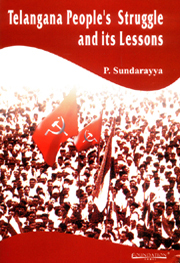Book contents
- Frontmatter
- Contents
- Preface
- Introduction
- PART I
- 1 Hyderabad State—its Socio-Political Background
- 2 The Peasant Upsurge and Communist Party
- 3 Armed Resistance Movement Against Nizam and Razakars
- 4 Telangana People's Armed Liberation Struggle Against Nizam – its Achievements
- 5 The Communist Movement in Andlira: Terror Regime—1948–1951
- PART II
- PART III
5 - The Communist Movement in Andlira: Terror Regime—1948–1951
from PART I
Published online by Cambridge University Press: 05 November 2011
- Frontmatter
- Contents
- Preface
- Introduction
- PART I
- 1 Hyderabad State—its Socio-Political Background
- 2 The Peasant Upsurge and Communist Party
- 3 Armed Resistance Movement Against Nizam and Razakars
- 4 Telangana People's Armed Liberation Struggle Against Nizam – its Achievements
- 5 The Communist Movement in Andlira: Terror Regime—1948–1951
- PART II
- PART III
Summary
Historical Background
Andhra is a contiguous area to Telangana. Now in 1971, it has a three-crore population and 12 districts. The 12 districts in the Andhra area can be divided again as follows; Circar or coastal districts (8); Rayalaseema districts (4); with the nine Telangana districts, now they constitute Andhra Pradesh. The boundaries now are: East—sea coast; South—Tamil Nadu, West—Karnataka; North— Maharashtra; North-East— Bastar area of Madhya Pradesh and Orissa.
Andhra had a predominantly peasant economy. While the Circar districts were comparatively more developed economically, socially and politically with a number of projects and other irrigation facilities, the Rayalaseema districts are backward in all respects, with a backward agriculture, no big projects and more domination of feudal relations and oppression. There were hardly any big industries except in Vizagapatnam district, where the shipbuilding yard owned by the Scindias and two jute mills owned by Europeans were situated. The rest of the working class was mostly dependent for its livelihood on petty industries such as tobacco, mica mines, foundries, rice and oil mills, etc. Ninety per cent of the whole population lived on agriculture in villages.
Communist Party
The Communist Party in Andhra was officially organised in September 1934. The development of the Communist movement in India was a terror for the imperialists and they banned it in 1934, even before its branches could be organised in Andhra.
The Communists, while working in the Congress organisation, conducted agitation on the demands of agricultural labourers and poor peasants in the villages and the working class in towns, and could build up their independent base among them, to a considerable extent.
- Type
- Chapter
- Information
- Telengana People's Struggle and it's Lessons , pp. 102 - 128Publisher: Foundation BooksPrint publication year: 2006



